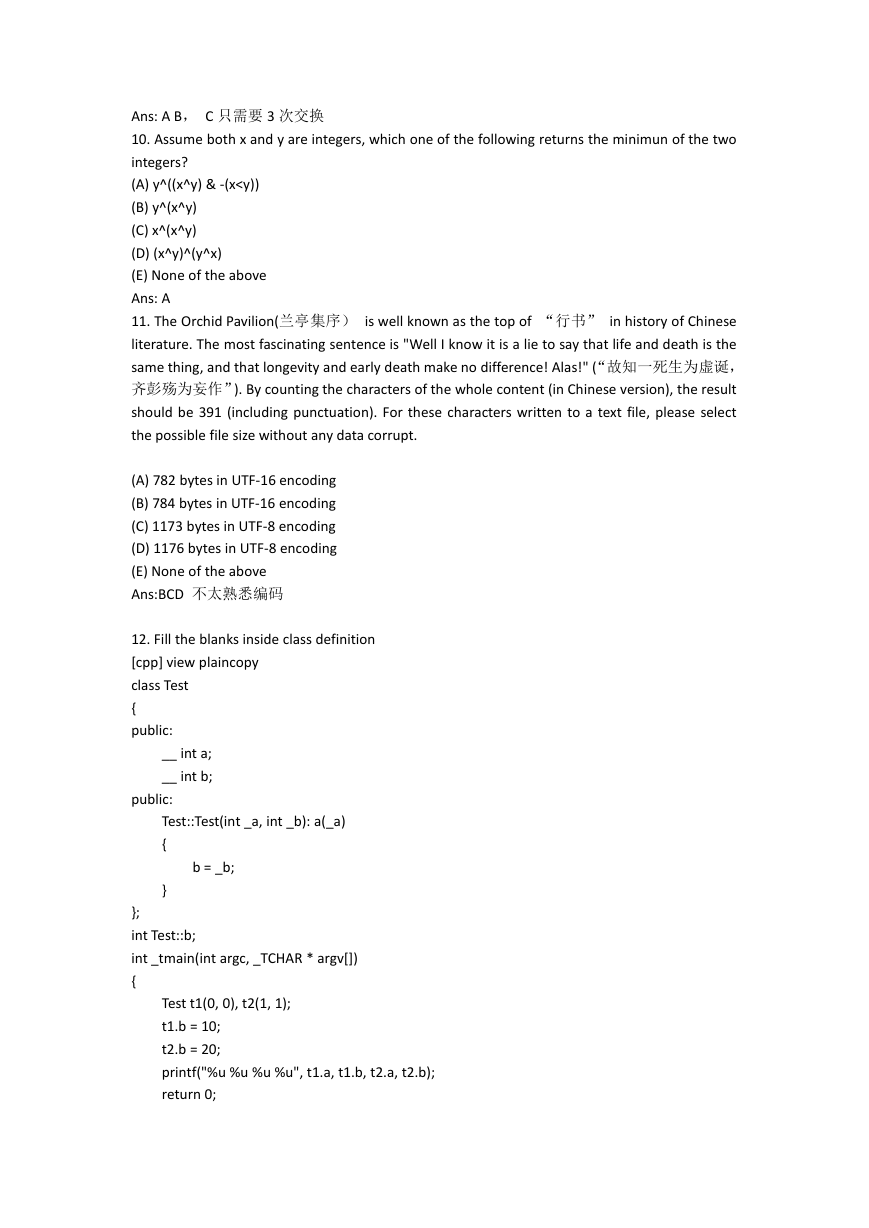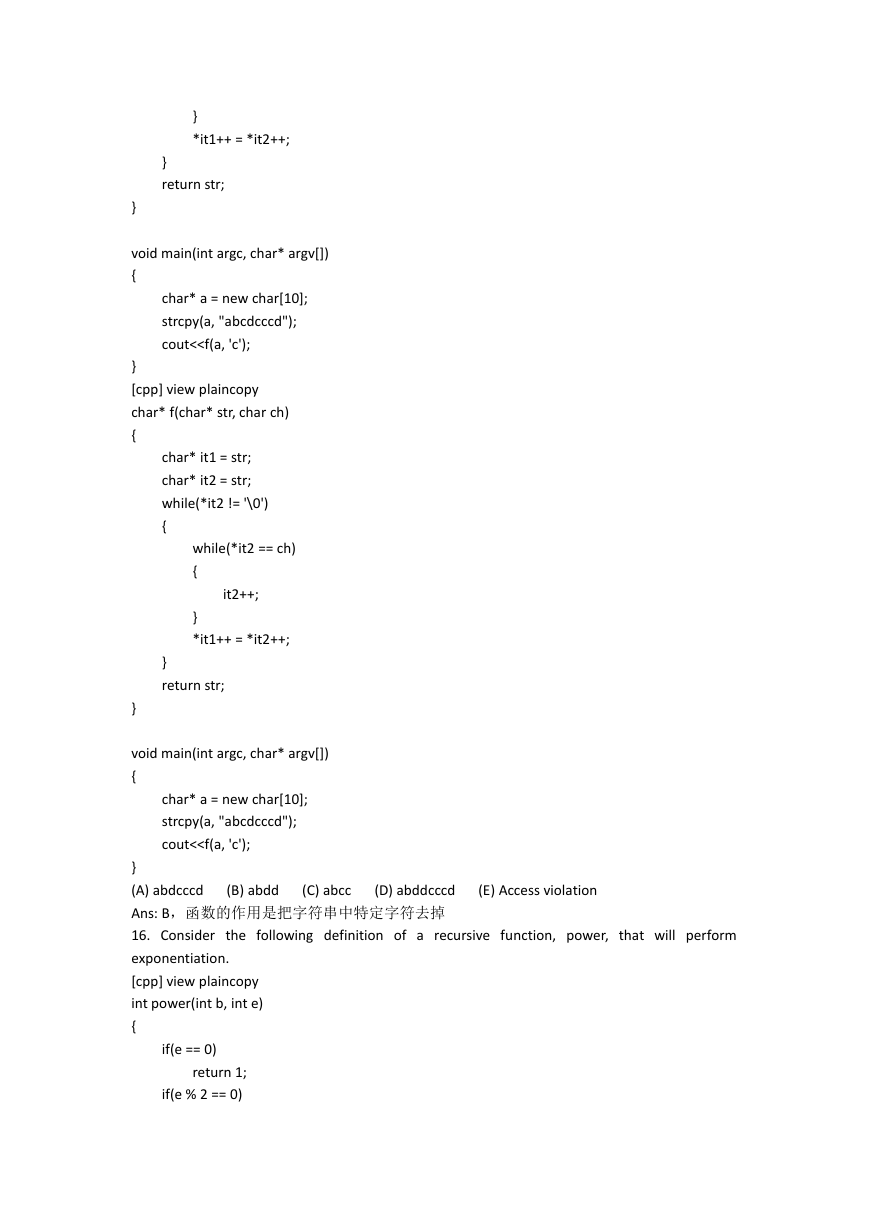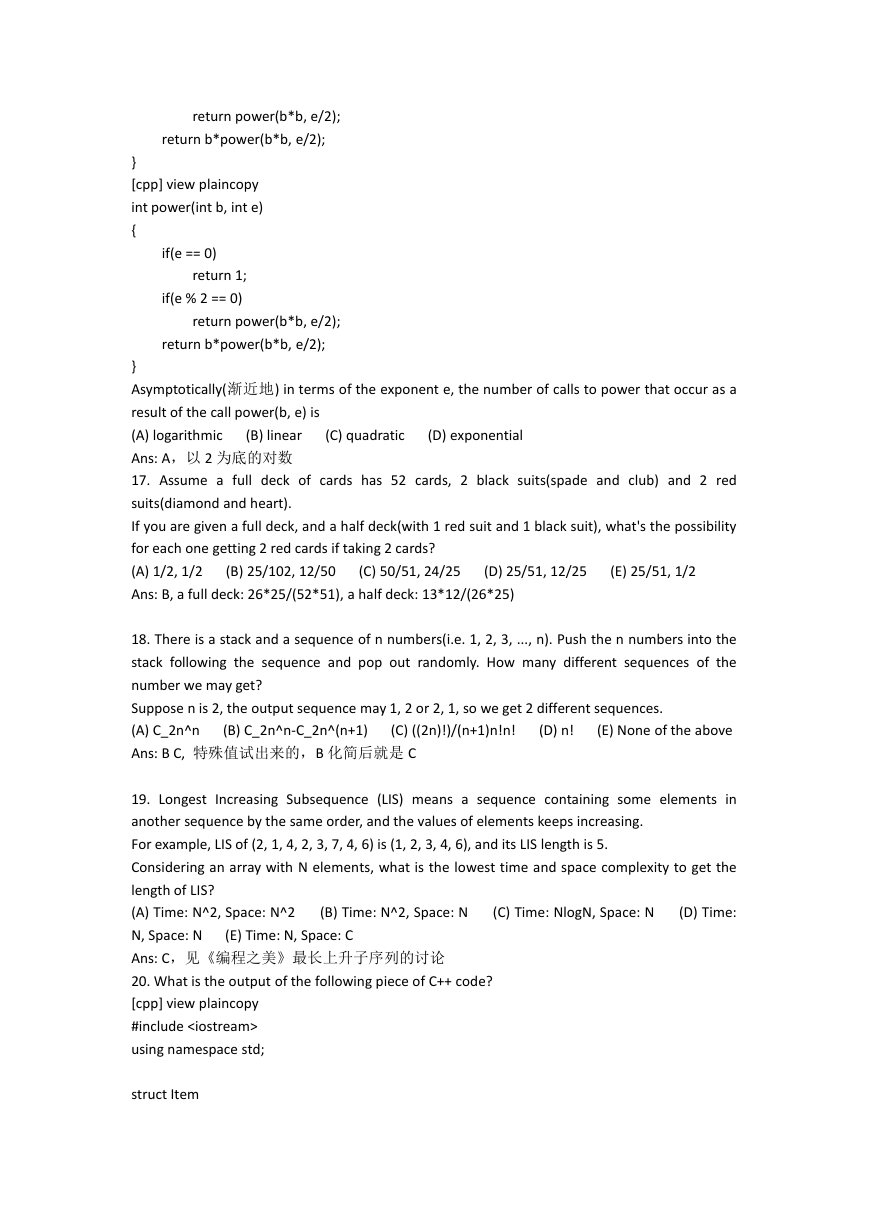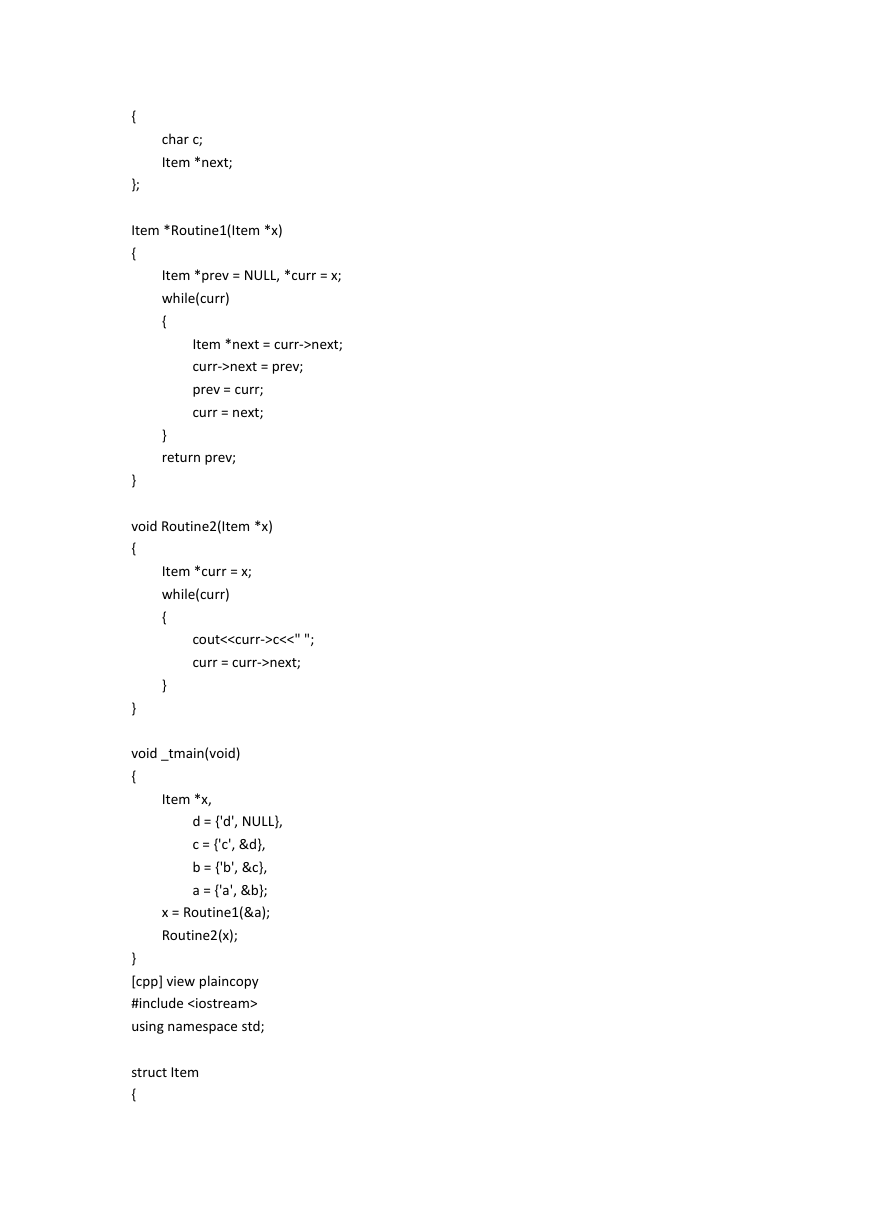1. Suppose that a Selection Sort of 80 items has completed 32 iterations of the main loop. How
many items are now guaranteed to be in their final spot (never to be moved again)?
对 80 个数进行选择排序,执行 32 个循环后,有多少个数已经固定位置?
(A) 16 (B) 31 (C) 32 (D) 39 (E) 40
Ans: C,考虑逆序的情况
2. Which synchronization mechanism(s)
processes/threads in operating system?
下列哪些机制可以避免进程(线程)间的竞争条件?
(A) Mutex (B) Mailbox (C) Semaphore (D) Local procedure call
Ans: A C,互斥量和信号量
is/are used to avoid race conditions among
3. There is a sequence of n numbers 1,2,3, ...,n and a stack which can keep m numbers at most.
Push the n numbers into the stack following the sequence and pop out randomly. Suppose n is 2
and m is 3, the output sequence maybe 1,2 or 2,1, so we get 2 different sequence. Suppose n is 7
and m is 5, please choose the output sequence of the stack.
(A) 1,2,3,4,5,6,7
(B) 7,6,5,4,3,2,1
(C) 5,6,4,3,7,2,1
(D) 1,7,6,5,4,3,2
(E) 3,2,1,7,6,5,4
Ans: A C
4. What is the result of binary number 01011001 after multiplying 0111001 and adding 1101110?
(A) 0001010000111111
(B) 0101011101110011
(C) 0011010000110101
Ans: A
5. What is output if you compile and execute the following C code?
[cpp] view plaincopy
int main()
{
int i = 11;
int const * p = &i;
p++;
printf("%d", *p);
return 0;
}
[cpp] view plaincopy
int main()
{
int i = 11;
int const * p = &i;
�
p++;
printf("%d", *p);
return 0;
}
(A) 11 (B) 12 (C) Garbage value (D) Compile error (E) None of above
Ans: C,p 指向 i 后的四字节内存,为任意值。
6. Which of following C++ code is correct?
(A)
[cpp] view plaincopy
int f()
{
int *a = new int(3);
return *a;
}
[cpp] view plaincopy
int f()
{
int *a = new int(3);
return *a;
}
(B)
[cpp] view plaincopy
int *f()
{
int a[3] = [1, 2, 3];
return a;
}
[cpp] view plaincopy
int *f()
{
int a[3] = [1, 2, 3];
return a;
}
(C)
[cpp] view plaincopy
vector f()
{
vector v[3];
return v;
}
�
[cpp] view plaincopy
vector f()
{
vector v[3];
return v;
}
(D)
[cpp] view plaincopy
void f(int * ret)
{
int a[3] = {1, 2, 3};
ret = a;
return;
}
[cpp] view plaincopy
void f(int * ret)
{
int a[3] = {1, 2, 3};
ret = a;
return;
}
(E) none of above
Ans: C,(A)申请内存后没有初始化,返回的是任意值;(B)返回 a 的地址,但数组 a 在栈区,
返回后栈就释放了;(C)印象中 vector 是在堆区,可行;(D)的问题同 B
7. Given that the 180-degree rotated image of a 5-digit number is another 5-digit number and the
difference between the number is 78633, what is the original 5-digit number?
(A) 60918
Ans: D, 89601-10968 = 78633
(D) 10968
(E) 86901
(B) 91086
(C) 18609
8. Which of the following statements are true
(A) We can create a binary tree from given inorder and preorder traversal seqences
(B) We can create a binary tree from given preorder and postorder traversal sequences
(C) For an almost sorted array, insertion sort can be more effective than Quicksort
(D) Suppose T(n) is the runtime of resolving a problem with n elements, T(n)=O(1) if n=1;
T(n)=2T(n/2)+O(n) if n>1; so T(n) is O(nlogn)
(E) None of the above
Ans: A D
9. Which of the following statements are true?
(A) Insertion sort and bubble sort are not eficient for large data sets.
(B) Quick sort makes O(n2) comparisons in the worst case
(C) There is an array: 7,6,5,4,3,2,1.
operation is 6
(D) Heap sort uses two heap operations: insertion and root deletion
(E) None of above
If using selection sort(ascending), the number of swap
�
Ans: A B, C 只需要 3 次交换
10. Assume both x and y are integers, which one of the following returns the minimun of the two
integers?
(A) y^((x^y) & -(x
}
[cpp] view plaincopy
class Test
{
public:
__ int a;
__ int b;
public:
Test::Test(int _a, int _b): a(_a)
{
b = _b;
}
};
int Test::b;
int _tmain(int argc, _TCHAR * argv[])
{
Test t1(0, 0), t2(1, 1);
t1.b = 10;
t2.b = 20;
printf("%u %u %u %u", t1.a, t1.b, t2.a, t2.b);
return 0;
(B) const/ static
}
Running result: 0 20 1 20
(A) static/ const
above
Ans: C
13. A 3-order B-tree has 2047 key words, what is the maximum height of the tree?
(A) 11
Ans: 不太了解 B 树,看完书在作答案
(D) const static/ static
(C) -/ static
(D) 14
(E) None of the
(B) 12
(C) 13
(D) inline
(C) extern
(B) virtual
14. In C++, which of the following keyword(s) can be used on both a variable and a function?
(A) static
Ans: A C E
15. What is the result of the following program?
[cpp] view plaincopy
char* f(char* str, char ch)
{
(E) const
char* it1 = str;
char* it2 = str;
while(*it2 != '\0')
{
while(*it2 == ch)
{
it2++;
�
}
*it1++ = *it2++;
}
return str;
}
void main(int argc, char* argv[])
{
char* a = new char[10];
strcpy(a, "abcdcccd");
cout<
return power(b*b, e/2);
return b*power(b*b, e/2);
}
[cpp] view plaincopy
int power(int b, int e)
{
if(e == 0)
return 1;
if(e % 2 == 0)
return power(b*b, e/2);
return b*power(b*b, e/2);
(C) quadratic
(D) exponential
}
Asymptotically(渐近地) in terms of the exponent e, the number of calls to power that occur as a
result of the call power(b, e) is
(A) logarithmic
(B) linear
Ans: A,以 2 为底的对数
17. Assume a full deck of cards has 52 cards, 2 black suits(spade and club) and 2 red
suits(diamond and heart).
If you are given a full deck, and a half deck(with 1 red suit and 1 black suit), what's the possibility
for each one getting 2 red cards if taking 2 cards?
(A) 1/2, 1/2
Ans: B, a full deck: 26*25/(52*51), a half deck: 13*12/(26*25)
(B) 25/102, 12/50
(D) 25/51, 12/25
(C) 50/51, 24/25
(E) 25/51, 1/2
18. There is a stack and a sequence of n numbers(i.e. 1, 2, 3, ..., n). Push the n numbers into the
stack following the sequence and pop out randomly. How many different sequences of the
number we may get?
Suppose n is 2, the output sequence may 1, 2 or 2, 1, so we get 2 different sequences.
(A) C_2n^n
Ans: B C, 特殊值试出来的,B 化简后就是 C
(B) C_2n^n-C_2n^(n+1)
(E) None of the above
(C) ((2n)!)/(n+1)n!n!
(D) n!
19. Longest Increasing Subsequence (LIS) means a sequence containing some elements in
another sequence by the same order, and the values of elements keeps increasing.
For example, LIS of (2, 1, 4, 2, 3, 7, 4, 6) is (1, 2, 3, 4, 6), and its LIS length is 5.
Considering an array with N elements, what is the lowest time and space complexity to get the
length of LIS?
(A) Time: N^2, Space: N^2
N, Space: N
Ans: C,见《编程之美》最长上升子序列的讨论
20. What is the output of the following piece of C++ code?
[cpp] view plaincopy
#include
using namespace std;
(C) Time: NlogN, Space: N
(B) Time: N^2, Space: N
(E) Time: N, Space: C
(D) Time:
struct Item
�
{
};
char c;
Item *next;
Item *Routine1(Item *x)
{
Item *prev = NULL, *curr = x;
while(curr)
{
Item *next = curr->next;
curr->next = prev;
prev = curr;
curr = next;
}
return prev;
}
void Routine2(Item *x)
{
Item *curr = x;
while(curr)
{
cout<c<<" ";
curr = curr->next;
}
}
void _tmain(void)
{
Item *x,
d = {'d', NULL},
c = {'c', &d},
b = {'b', &c},
a = {'a', &b};
x = Routine1(&a);
Routine2(x);
}
[cpp] view plaincopy
#include
using namespace std;
struct Item
{
�
















 2023年江西萍乡中考道德与法治真题及答案.doc
2023年江西萍乡中考道德与法治真题及答案.doc 2012年重庆南川中考生物真题及答案.doc
2012年重庆南川中考生物真题及答案.doc 2013年江西师范大学地理学综合及文艺理论基础考研真题.doc
2013年江西师范大学地理学综合及文艺理论基础考研真题.doc 2020年四川甘孜小升初语文真题及答案I卷.doc
2020年四川甘孜小升初语文真题及答案I卷.doc 2020年注册岩土工程师专业基础考试真题及答案.doc
2020年注册岩土工程师专业基础考试真题及答案.doc 2023-2024学年福建省厦门市九年级上学期数学月考试题及答案.doc
2023-2024学年福建省厦门市九年级上学期数学月考试题及答案.doc 2021-2022学年辽宁省沈阳市大东区九年级上学期语文期末试题及答案.doc
2021-2022学年辽宁省沈阳市大东区九年级上学期语文期末试题及答案.doc 2022-2023学年北京东城区初三第一学期物理期末试卷及答案.doc
2022-2023学年北京东城区初三第一学期物理期末试卷及答案.doc 2018上半年江西教师资格初中地理学科知识与教学能力真题及答案.doc
2018上半年江西教师资格初中地理学科知识与教学能力真题及答案.doc 2012年河北国家公务员申论考试真题及答案-省级.doc
2012年河北国家公务员申论考试真题及答案-省级.doc 2020-2021学年江苏省扬州市江都区邵樊片九年级上学期数学第一次质量检测试题及答案.doc
2020-2021学年江苏省扬州市江都区邵樊片九年级上学期数学第一次质量检测试题及答案.doc 2022下半年黑龙江教师资格证中学综合素质真题及答案.doc
2022下半年黑龙江教师资格证中学综合素质真题及答案.doc